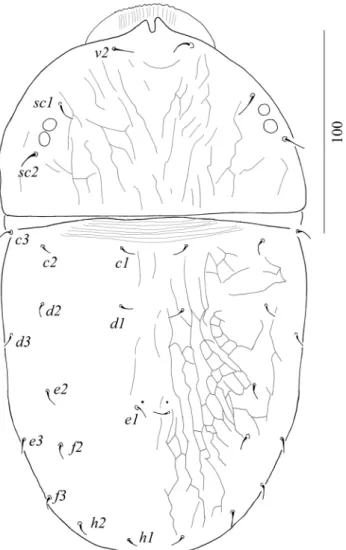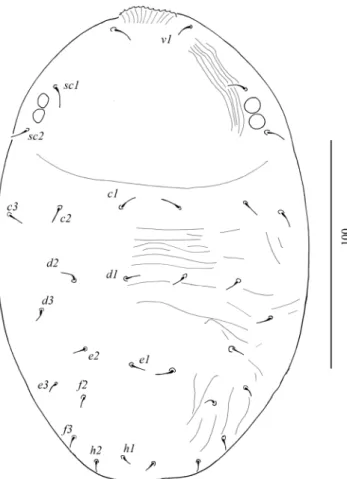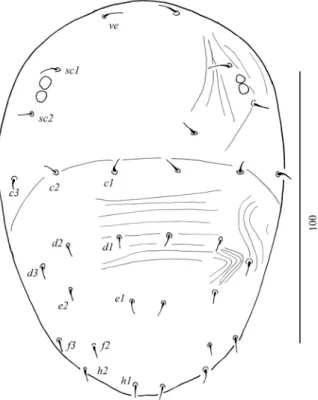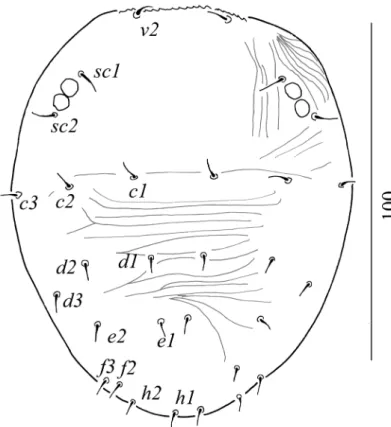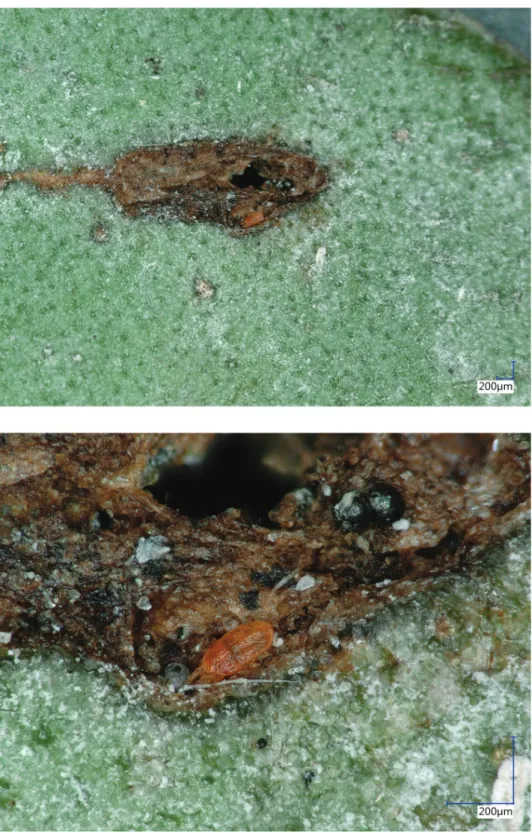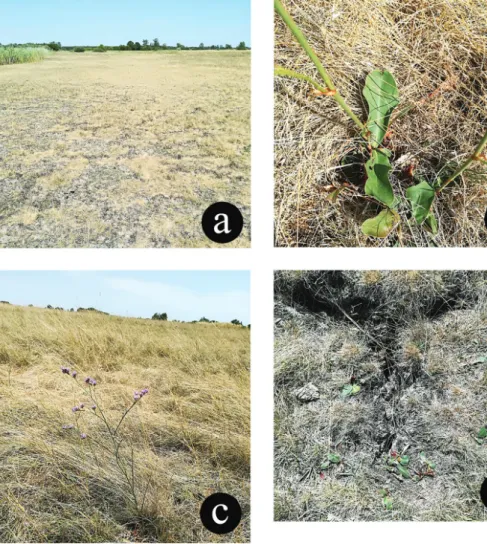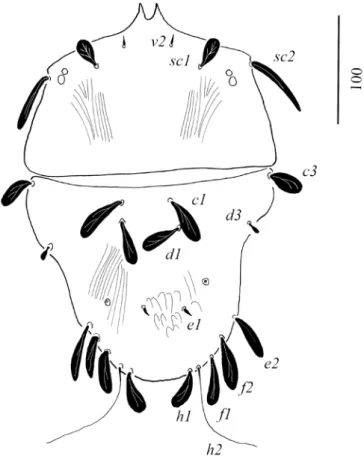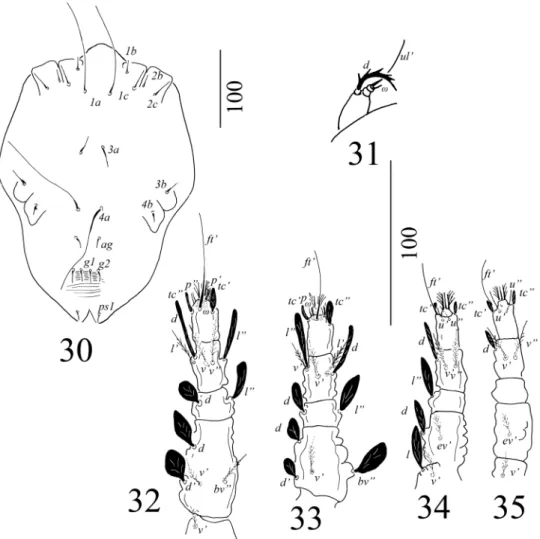A new species of Aegyptobia and redescription of Tenuipalpus szarvasensis... 99
A new species of Aegyptobia and redescription of Tenuipalpus szarvasensis Bozai, 1970
(Acari, Tenuipalpidae)
Jenő Kontschán1, Géza Ripka2
1 Plant Protection Institute, Centre for Agricultural Research, Hungarian Academy of Sciences, H-1525 Buda- pest, P.O. Box 102, Hungary 2 National Food Chain Safety Office, Directorate of Plant Protection, Soil Con- servation and Agri-environment, Department of Pest Management Development and Coordination, H-1118 Budapest, Budaörsi út 141–145, Hungary
Corresponding author: Jenő Kontschán (kontschan.jeno@agrar.mta.hu)
Academic editor: V. Pesic | Received 21 June 2018 | Accepted 5 August 2018 | Published 19 September 2018 http://zoobank.org/BE84A4DE-2A3D-4306-8166-097810EB84BF
Citation: Kontschán J, Ripka G (2018) A new species of Aegyptobia and redescription of Tenuipalpus szarvasensis Bozai, 1970 (Acari, Tenuipalpidae). ZooKeys 785: 99–115. https://doi.org/10.3897/zookeys.785.27684
Abstract
A new tenuipalpid mite species, Aegyptobia bozaii sp. n., is described from Central-Hungary on leaves of the endemic Hungarian statice Limonium gmelinii subsp. hungaricum (Plumbaginaceae) based on females, nymphs and larva. The previously described endemic flat mite, Tenuipalpus szarvasensis Bozai, 1970 is re- described. This species had been treated as a junior synonym of Tenuipalpus cheladzeae Gomelauri, 1960, but our new investigation shows that the two species are not the same.
Keywords
tenuipalpids, mites, flat mite, taxonomy, Hungary
Introduction
Tenuipalpid mites are a diverse group of plant-feeding mites found in most regions of the world. Several species are pests, especially within Brevipalpus, but pest species are also found in Dolichotetranychus, Raoiella and Tenuipalpus. The family has received considerable attention in some parts of the world, but the majority of the Central
ZooKeys 785: 99–115 (2018) doi: 10.3897/zookeys.785.27684 http://zookeys.pensoft.net
Copyright Jenő Kontschán, Géza Ripka. This is an open access article distributed under the terms of the Creative Commons Attribution License (CC BY 4.0), which permits unrestricted use, distribution, and reproduction in any medium, provided the original author and source are credited.
RESEARCH ARTICLE
Launched to accelerate biodiversity research A peer-reviewed open-access journal
European countries have been scarcely investigated. Hungary is no exception, with only 19 recorded species (Kontschán and Ripka 2017). However, numerous rare and endemic flat mites might remain undiscovered in natural ecosystems in Hungary; and disturbed ecosystems may harbor several unrecorded or possibly new species.
The aim of our paper is to describe a new tenuipalpid species from Hungary and to redescribe the endemic Hungarian flat mite Tenuipalpus szarvasensis Bozai, 1970, which we also remove from its synonymy with Tenuipalpus cheladzeae Gomelauri, 1960 by Mitrofanov and Strunkova (1979).
Material and methods
Specimens of the new species (Aegyptobia bozaii sp. n.) were collected in a pasture close the border of the village Farmos (Central-Hungary) from the leaves of an endemic Hungarian plant (Limonium gmelinii subsp. hungaricum). The specimens were placed into lactic acid for a week and then slide-mounted in Keifer’s F-medium (in 2014) and Hoyer medium (in 2017). The holotype and some paratypes of the new species are stored in the Hungarian Natural History Museum and other paratypes in the Arach- nida collection of the Natural History Museum of Geneva (Switzerland).
The type specimens of Tenuipalpus szarvasensis Bozai, 1970 were loaned from the Hungarian Natural History Museum.
All specimens were investigated using a Leica 1000 scientific microscope; the il- lustrations were made with the aid of a drawing tube on this microscope. Pictures were made with a VHX-5000 with 20–200× objective (Keyence Co., Osaka, Japan) digital microscope. All measurements and scales are given in micrometers.
Result
Aegyptobia bozaii sp. n.
http://zoobank.org/CF433BD9-1455-4EE2-84F3-DFF3ABCC858C Figures 1–26
Material examined. Holotype: female, Hungary, Pest county, Farmos, 47°22'30"N, 19°52'08"E, 10 m a.s.l, from the leaves of the Hungarian statice, Limonium gmelinii subsp. hungaricum, 2 August 2014, Ripka, G. coll. Paratypes: one female, three deu- tonymphs, three protonymphs and one larva, locality and date same as for holotype.
Other paratypes: four females, Hungary, Farmos, 47°22'30"N, 19°52'08"E, 10 m a.s.l, from the leaves of Limonium gmelinii subsp. hungaricum, 2 August 2017, Kontschán, J. and Ripka, G. coll.
Diagnosis (based on female). Tarsal claws uncinate. Anterior margin of prodorsal shield with paired projections, prodorsum weakly sculptured, with few irregular li- nes. Opisthosoma with polygonal reticulation. Propodosomal and opisthosomal setae
A new species of Aegyptobia and redescription of Tenuipalpus szarvasensis... 101
Figure 1. Dorsal view of Aegyptobia bozaii sp. n., holotype, female.
smooth and simple; seta f2 present. Length of dorsal setae 6–14. Dorsal opisthosomal pores close to e1. Rostrum extending to middle of tibia I. Genital flap smooth. Inter- coxal area between 3a and 4a smooth.
Description (females; n = 6). Idiosoma reddish-brown (Figure 27), oval in shape, body measured from v2 to h1 240–245; from tip of rostrum 260–266; width 143–147 near setae sc2; distance between setae sc2 120–125; length of legs I–IV (without coxa), leg I 105–110, leg II 80–87, leg III 72–78, leg IV 80–88.
Dorsum (Figure 1): Anterior margin of prodorsal shield with paired projections, depth of notch 7–8. Propodosoma finely lineate. Opisthosoma with polygonal reticu- lations; polygons longitudinally elongate medially, transversally elongate anterolater- ally. Propodosomal and opisthosomal setae simple and smooth. Opisthosomal pores present close to e1. Prodorsal setae v2 shorter than half distance between their bases.
Length of dorsal setae: v2 11–12, sc1 12–14, sc2 11–13, c1 8–9, c2 8–9, c3 9–10, d1 9–10, d2 8–9, d3 7–8, e1 8–9, e2 7–8, e3 8–9, f2 7–8, f3 6–8, h1 6–7, h2 7–8.
Venter (Figure 2): Surface of ventral idiosoma smooth, except lateral to ag, genital and anal plates where longitudinal striations visible. Genital and anal plates smooth.
Length of ventral setae, 1a 53–57, 3a 11–12, 4a 8–9, 1b 7–8, 2b 8–9, 3b 8–9, 4b 9–10, 1c 11–12, 2c 10–13, ag 8–9, g1 9–10, g2 7–8. Pseudanal setae, all 6–8. All ven- tral setae simple and smooth.
Gnathosoma (Figure 3): Rostrum extending to middle of tibia I; palp setal counts:
tarsus with one solenidion and two eupathidia, tibia with two setae, genu without seta and femur with one simple dorsal seta. All setae smooth. Subcapitulum with setae m (4–5).
Legs (Figures 4–8): Setal formula for leg I-IV (coxae to tarsi): 3-1-4-3-3-9, 2-1-4- 3-3-9, 2-2-2-1-3-5, 2-1-1-0-3-5. A supplementary lateral (l’) seta present on femora I. Solenidia on tarsi I and II 8–10 long, broad, leaf-like. Tarsal claws uncinate and empodium pad-like.
Deutonymph (n = 3; Figures 9–15). Idiosoma oval in shape, body measured from v2 to h1 190–200; width 130–140 near setae sc2.
Dorsum (Figure 9) covered with a few striae, all setae short, simple and needle-like.
Length of all setae 5–7.
Venter covered with very few striae with one pair of setae 1a, 1b, 2b, 3a, 3b, 3c, 4a and 4b, one pair of aggenital, one pair of genital and three pairs of anal setae, all simple and smooth 1a 15–16, other setae on venter 5–7 (Figure 10). Palp setal counts:
tarsus with one solenidion and two eupathidia, tibia with two setae, genu without seta and femur with one simple dorsal seta (Figure 11). Legs as Figures 12–15 and Table 1.
Protonymph (n = 3; Figures 16–21). Idiosoma oval in shape, body measured from v2 to h1 149–155; width 94–100 near setae sc2.
Dorsum (Figure 16). Surface without striae, all setae short, simple and needle-like.
All setae 4–6 in length.
Venter covered with very few striae with one pair of setae 1a, 1b, 2b, 3a and 3b, one pair of aggenital and three pairs of anal setae, all simple and smooth. 1a 13–15, other setae on venter 5–6 (Figure 17). Legs as Figures 18–21 and Table 1.
Larva (n = 1; Figures 22–26). Idiosoma oval in shape, body measured from v2 to h1 109; width 82 near setae sc2.
Dorsum (Figure 22). Covered with a few striae, all setae short, simple and needle- like. Length of setae: v2 30–31; sc1 30–37; sc2 28–36; c1 29–38; c2 26–39; c3 31–37;
d1 5; d3 37–43; e1 3; e3 40–54; f2 3–4; f3 64–66; h1 2–3; h2 2–5.
Venter covered with few striae with one pair of setae 1a and three pairs of anal setae, all simple and smooth (Figure 23). Legs as Figures 24–26 and Table 1.
Etymology. We dedicate the new species to Dr. József Bozai, former Hungarian tenuipalpid specialist.
Notes on the host. The host plant, Hungarian statice (Limonium gmelinii subsp.
hungaricum) (Plumbaginaceae), is an endemic subspecies occurring on salt meadows in Central-Hungary. The mites appeared to prefer leaves of the host plant that were lying close to the surface of the soil. The alkali steppe where the host plant was found
A new species of Aegyptobia and redescription of Tenuipalpus szarvasensis... 103
Figures 2–8. Aegyptobia bozaii sp. n., holotype, female 2 Ventral view of idiosoma 3 Ventral view of gnathosoma 4 Ventral view of leg I 5 Ventrolateral view of tarsus I 6 Ventral view of leg II 7 Ventral view of leg III 8 Ventral view of leg IV.
Figure 9. Dorsal view of Aegyptobia bozaii sp. n., paratype, deutonymph.
is hot and dry in summer, typical habitat for tenuipalpid species, which prefer warm and dry conditions. Up until now, only one species has been reported from Limonium plants: Capedulia maritima Gerson & Smith Meyer, 1980 was found on the roots of Limonium meyeri in Israel (Ueckermann et al. 2018).
Remarks. The new species has uncinate claws and therefore belongs to the Ae- gyptobia tragardhi species group (Khanjani et al. 2008). It is very similar to A. iranensis Khanjani et al., 2008 and A. wainsteini Bagdasarian, 1962 based on the claw-like empodium, the slender prodorsal setae, the deeply emarginated notch and the me- dially smooth prodorsum. The most important differences among three species are summarized in Table 2.
Only one species, Aegyptobia wainsteini Bagdasarian, 1962, was previously re- ported from Hungary from a Biota orientalis tree (Cupressaceae) close to the town Kecskemét (Bozai 1969). Other new occurrences have not been given since this first report. The two Aegyptobia species reported from Hungary differ in the shape of the dorsal setae, which are short and smooth in A. bozaii sp. n. and longer and finely pilose on Aegyptobia wainsteini.
A new species of Aegyptobia and redescription of Tenuipalpus szarvasensis... 105
Figures 10–15. Aegyptobia bozaii sp. n., paratype, deutonymph 10 Ventral view of idiosoma 11 Ventral view of palp 12 Ventral view of leg I 13 Ventral view of leg II 14 Ventral view of leg III 15 Ventral view of leg IV.
Figure 16. Dorsal view of Aegyptobia bozaii sp. n. paratype, protonymph.
Table 1. Development of leg setae (after Seeman and Beard 2011).
Cx I Cx II Cx III Cx IV Tr
I Tr
II Tr III Tr
IV Fe I* Fe II Fe III
1a 1b 1c 2b 2c 3a 3b 4a 4b v’ v’ l’ v’ v’ d v’ bv” d v’ bv” d ev’
Larva + + + + + + + + + + +
PN + + + + + + + + + + + + + + +
DN + + + + + + + + + + + + + + + + + + + + +
Adult + + + + + + + + + + + + + + + + + + + + + +
Fe IV Ge I Ge II Ge
III Ti I** Ti II Ti III Ti IV
ev’ l’ d l” l’ d l” l’ d l’ v’ v” d l’ v’ v” d v’ v” d v’ v”
Larva + + + + + + + + + + + +
PN + + + + + + + + + + + + + + + + + +
DN + + + + + + + + + ? + + + ? + + + + + + + +
Adult + + + + + + + + + ? + + + ? + + + + + + + +
Ta I-II Ta III Ta IV
u’ u” p’ p” tc’ tc” ft’ ft” ω u’ u” p’ p” tc’ tc” ft’ u’ u” tc’ tc” ft’
Larva + + + + + + + + + +
PN + + + + + + + + + + + + + + + + + + +
DN + + + + + + + + + + + + + + + + + + + + +
Adult + + + + + + + + + + + + + + + + + + + + +
* The new species has a supplementary lateral (l’) seta on femora I.
** The setae l’ on tibiae I and II in adult female and deutonymphs are not visible.
A new species of Aegyptobia and redescription of Tenuipalpus szarvasensis... 107
Figures 17–21. Aegyptobia bozaii sp. n., paratype, protonymph 17 Ventral view of idiosoma 18 Ventral view of leg I 19 Ventral view of leg II 20 Ventral view of leg III 21 Ventral view of leg IV.
Table 2. Distinguishing characteristics among Aegyptobia bozaii, A. iranensis and A. wainsteini.
Character Aegyptobia bozaii Aegyptobia iranensis Aegyptobia wainsteini Surface between c1 and d1 with large reticulations with large reticulations smooth Distance between setae v2 three times longer than
length of v2
two times longer than length
of v2 same as length of v2 Setae 3a 1/2 the distance 3a-3a two times the distance 3a-3a 1/2 the distance 3a-3a
Tenuipalpus szarvasensis Bozai, 1970 Tenuipalpus szarvasensis Bozai, 1970: 367.
Tenuipalpus cheladzeae Gomelauri, 1960 as senior synonym of T. szarvasensis by Mitro- fanov and Strunkova 1979: 51.
Tenuipalpus cheladzeae: Kontschán and Ripka 2017.
Material examined. Holotype: female, HNHM Astig-242, Szarvas, 8 October 1968, from Picea excelsa Lk. No. 1250, Bozai, J. coll.
Diagnosis (based on female). Anterior margin of prodorsal shield with forked projection; prodorsum smooth medially, with some striae laterally; anterolateral pro- jections carrying setae sc2 weakly formed. Opisthosoma smooth anteriorly, with pos- teromedial reticulation and posterolateral longitudinal striation. Propodosomal setae as follows: v2 short and smooth, sc1 broad and obovate, sc2 long and phylliform.
Opisthosomal setae: c1, c3 and d1 broad, long, oblanceolate, d3 short and oblan- ceolate, e1 short and smooth, h1, f1, f2 and e3 long, oblanceolate, h2 very long and smooth. Rostrum extending to middle of tibia I. Genital flap smooth. Intercoxal area
Figure 22. Dorsal view of Aegyptobia bozaii sp. n., paratype, larva.
A new species of Aegyptobia and redescription of Tenuipalpus szarvasensis... 109
Figures 23–26. Aegyptobia bozaii sp. n., paratype, larva 23 Ventral view of idiosoma 24 Ventral view of leg I 25 Ventral view of leg II 26 Ventral view of leg III.
between 3a and 4a smooth, 1a and 4a very long, 1b, 2b, 2c, 3a, 3b, 4b, ag, g1, g2 short.
Legs with large, broad and phylliform, smooth and pilose setae.
Description (female holotype). Colorization of idiosoma not observable in the holotype. Idiosoma (Figure 27) pentagonal in shape, body measured from v2 to h1 305; from tip of rostrum 350; width between setae sc2 190.
Figure 27. Photos of the female of Aegyptobia bozaii sp. n., paratype.
A new species of Aegyptobia and redescription of Tenuipalpus szarvasensis... 111
Dorsum (Figure 29): Anterior margin of prodorsal shield with paired projections, depth of notch 16. Prodorsum smooth medially, with some striae laterally; antero- lateral projections carrying setae sc2 weakly formed. Opisthosoma smooth anteriorly, with posteromedial reticulation and posterolateral longitudinal striation. Propodoso- mal setae as follows: v2 short and smooth, sc1 broad and obovate, sc2 long and phyl- liform. Opisthosomal setae: c1, c3 and d1 broad, long, oblanceolate, d3 short and oblanceolate, e1 short and smooth, h1, f1, f2 and e3 long, oblanceolate, h2 very long and smooth. Rostrum extending to middle of tibia I. Opisthosomal pores between d1 and e1. Length of dorsal setae: v2 9–10, sc1 30–32, sc2 65, c1 45–46, c3 32–34, d1 38–40, d3 12–14, e1 12, e2 45–47, f2 and f3 45–46, h1 36–37, h2 105–110.
Venter (Figure 30): Very few striations observable in the holotype, only a few lon- gitudinal striations visible posterior to g1–g2. Genital and anal plates smooth. Length of ventral setae, 1a 120–122, 3a 26–27, 4a 130–133, 1b 16, 2b 16–17, 3b 18–19, 4b
Figure 28. Habitat and details of the host plant. a Habitat b Host plant c–d Leaves of host plant.
Figure 29. Dorsal view of Tenuipalpus szarvasensis Bozai, 1970, holotype, female.
13, 1c and 2c 24–25, ag 12, g1–g2 14–16. Pseudanal setae, all 12–13. All ventral setae simple and smooth.
Gnathosoma: Rostrum extending to middle of tibia I; palp setal counts as in Figure 31.
Legs: Setal formula for leg I–IV (coxae to tarsi): 3-1-4-2-5-9, 2-1-4-2-4-9, 2-2-2- 1-3-5, 2-1-1-0-3-5. Shape of the setae on legs illustrated on Figures 32–35.
Notes. Bozai’s (1970) noted in his detailed description of Tenuipalpus szarvasensis, that the species is very similar to T. cheladzeae, but he mentioned some easy to observe differences (like shape and length of setae c1, d1) between these two species. Despite these known differences, Mitrofanov and Strunkova (1979) synonymized the name under Tenuipalpus cheladzeae. Mitrofanov and Strunkova (1979) did not study the type specimens of T. szarvasensis, therefore their opinion was questionable.
This year, we studied the types of Bozai’s T. szarvasensis in order to confirm Bozai’s hypothesis that T. szarvasensis differs from Gomelauri’s T. cheladzeae. The differences are presented in Table 3 and are illustrated in Figures 36, 37.
Tenuipalpus is the largest genus of flat mites, but very few are known from Pinaceae. Apart from the above-mentioned two species, the only other species is T. hondurensis Evans, in Evans et al. (1993) (Mesa et al. 2009), which is consider- ably different from both the above species. Tenuipalpus cupressoides Smith, Meyer
A new species of Aegyptobia and redescription of Tenuipalpus szarvasensis... 113
Figures 30–35. Tenuipalpus szarvasensis Bozai, 1970, holotype, female 30 Ventral view of idiosoma 31 Dorsal view of palp 32 Ventral view of leg I 33 Ventral view of leg II 34 Ventral view of leg III 35 Ventral view of leg IV.
Table 3. Distinguishing characters between Tenuipalpus cheladzeae and T. szarvasensis.
Character T. cheladzeae T. szarvasensis
Shape of v2 apically rounded apically pointed
Shape of sc1 short (12–14) and bulbiform long (30–32) and phylliform Shape of c1 and d1 short (c1 10–11, d1 9–11) and bulbiform long (c1 45–46, d1 38–40) and phylliform
& Gerson, 1980 is very similar to T. szarvasensis, but the shape of v2 and e2 and the length of sc1, c1 and d1 are different. In addition, the host plant, Cupressus sem- pervirens of T. cupressoides belongs to the family Cupressaceae and not to Pinaceae (Ueckermann et al. 2018).
Acknowledgements
This study was supported by the NKFIH (OTKA) 108663 and by the János Bolyai Research Scholarship of the Hungarian Academy of Sciences. We are very grateful to Dr. Owen D. Seeman for the correction of the previous version of the manuscript and his linguistic corrections.
References
Bagdasarian AT (1962) Contribution to the fauna of false spider mites from Armenia. Izvestiia Akademii Nauk SSR, Moscow 15: 49–58.
Bozai J (1969) Új lapostestű atkák Magyarországon (Tenuipalpidae, Acari). (Some tenuipalpids (Acari) new for the fauna of Hungary.) Folia Entomologica Hungarica 22: 117–130.
Bozai J (1970) Tenuipalpus szarvasensis sp. n., a new mite species from Hungary (Acari: Tenui- palpidae). Acta Zoologica Academiae Scientiarum Hungaricae 16(3–4): 367–369.
Evans G, Cromroy HL, Ochoa R (1993) The Tenuipalpidae of Honduras (Tenuipalpidae: Aca- ri). Florida Entomologist 76(1): 126–155. https://doi.org/10.2307/3496021
Gerson U, Smith Meyer MKP (1980) A new species of Capedulia (Acari: Tenuipalpidae) from a marine habitat in Israel. Israel Journal of Entomology 14: 9–12.
Figures 36–37. Illustrated differences between T. szarvasensis (36) and T. cheladzeae (37) Drawing of T.
cheladzeae modified after Mitrofanov and Strunkova (1979).
A new species of Aegyptobia and redescription of Tenuipalpus szarvasensis... 115 Gomelauri LA (1960) New species in the genus Tenuipalpus from the Georgia, Gruzia, SSR
(Acarina: Tenuipalpidae). Reports of the Academy of Science of the Georgian SSR. Soobs- hcheniya Akademii Nauk Gruzinskoi 24(1): 77–79.
Khanjani M, Gotoh T, Varandi HB (2008) A new species of the genus Aegyptobia Sayed (Acari:
Prostigmata, Tenuipalpidae) from Iran. Systematic & Applied Acarology 13(1): 65–69.
https://doi.org/10.11158/saa.13.1.7
Kontschán J, Ripka G (2017) Checklist of the Hungarian spider mites and flat mites (Acari:
Tetranychidae and Tenuipalpidae). Systematic & Applied Acarology 22(8): 1199–1225.
https://doi.org/10.11158/saa.22.8.6
Mesa NC, Ochoa R, Welbourn WC, Evans G, Moraes GJ de (2009) A catalog of the Tenuipal- pidae (Acari) of the World with a key to genera. Zootaxa 2098: 1–185.
Mitrofanov VI, Strunkova ZI (1979) Opredelitelj kleshchej-ploszkotelok. Izdateljsztvo „Donis”
Dushanbe, 148 pp.
Seeman OD, Beard JJ (2011) A new species of Aegyptobia (Acari: Tenuipalpidae) from Myrta- ceae in Australia. Systematic & Applied Acarology 16: 73–89. https://doi.org/10.11158/
saa.16.1.10
Ueckermann EA, Palevsky E, Gerson U, Recht E, Theron PD (2018) The Tenuipalpidae (Acari:
Trombidiformes) of Israel. Acarologia 58(2): 483–525.
